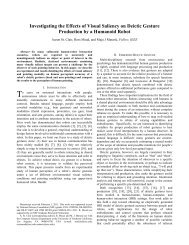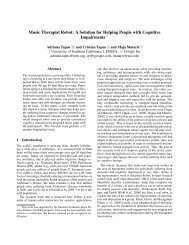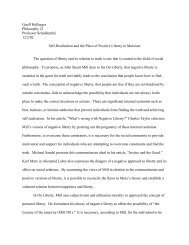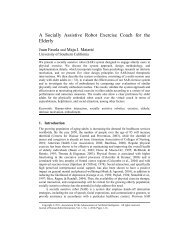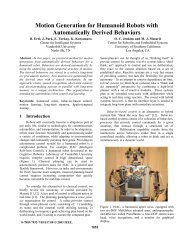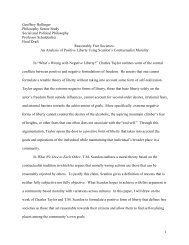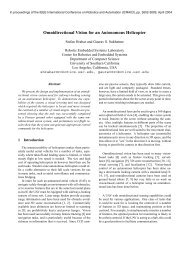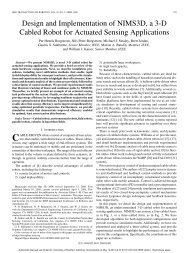A Scalable Approach to Human-Robot Interaction - USC Robotics ...
A Scalable Approach to Human-Robot Interaction - USC Robotics ...
A Scalable Approach to Human-Robot Interaction - USC Robotics ...
You also want an ePaper? Increase the reach of your titles
YUMPU automatically turns print PDFs into web optimized ePapers that Google loves.
odometry for laser beacon-based localization andnavigation. The sonar is used for obstacle avoidance.The first system is a multi-robot, multi-target trackingsystem [9], configured <strong>to</strong> detect three different targetsidentified by colored beacons. Hence, three services aregenerated and provide target location information. For theexperiments, the system consists of three robotsconfigured <strong>to</strong> be either stationary or dynamic trackers.Using the infrastructure, the system client can manage up<strong>to</strong> 10 requests simultaneously.The second system offers one service and consists of adelivery robot that navigates <strong>to</strong> goal locations provided bythe requesting user. It provides task status details ofproximity <strong>to</strong> the goal location and the robot’s currentpose. A new goal location can be entered at any time. Thedelivery robot has a ‘home’ location in an office where itreturns <strong>to</strong> whenever it is not tasked. For long durationexperiments, this location could contain a docking stationfor recharging.The two systems share the same environment map andcoordinate reference frame so location information iscommon between them. This map was used in the earliersimulation experiments. No calibration had <strong>to</strong> be carriedout for real robot localization, which is a testament <strong>to</strong> theaccuracy of the map used in Stage and the effectiveness ofusing Stage for real robot system development.Experiment 1 – Small Scalability AnalysisThe first experiment involves several users requestingtasks from the systems. The three tracking robots areconfigured <strong>to</strong> act as stationary sensors. The area of thetracking system’s coverage is shown by the gray areas inFigure 3. The target <strong>to</strong> be tracked is the delivery robotwhich is tasked through the infrastructure <strong>to</strong> travel <strong>to</strong>locations in the corridors within the tracking system’scoverage.The infrastructure operates as follows. The systemsconnect <strong>to</strong> the infrastructure, register their services andwait for requests. The users connect <strong>to</strong> the infrastructureand receive the global list of services, consisting of thethree tracking services for the differently colored targetsand one delivery service. The users select whicheverservice they desire and are connected <strong>to</strong> the applicablesystem. They then have a one-<strong>to</strong>-one interaction for eachsystem they are connected <strong>to</strong>. Additionally, they retainaccess <strong>to</strong> the global service list for many-<strong>to</strong>-manyinteraction.The experiment ran for approximately 50 minuteswith 10 users connecting <strong>to</strong> the infrastructure andperiodically requesting and terminating services. Figure 4shows the server’s performance during the experiment.The data shown represents the time for the server <strong>to</strong>process service request, list request, and servicetermination messages. The instantaneous number ofonline users is also shown. As can be seen, the number ofusers has little effect on the response times. The mainreason for this is that the infrastructure’s operations areevent-based on the user’s side. Therefore, connected usersrequire no maintenance when there is no activity. On thesystem side, a ping signal is sent from the server every 20seconds <strong>to</strong> ensure all systems connected <strong>to</strong> it are stillserviceable. A system has 10 seconds <strong>to</strong> respond before itand its services are removed from the server.50454035302520151050RequestListTerminate#Users1 306 610 913 1217 1522 1828 2132 2436 2739 3044Time (s)Figure 4. Server response times for Experiment 1. The numberof users connected at any point in time is represented by thesolid line and the right y axis. The server’s response times <strong>to</strong> thevarious messages are shown by the symbols and correlate <strong>to</strong> theleft y axis.While the server’s response times <strong>to</strong> requests provideevidence of its efficiency, the response times from theuser’s perspective provides a better indication <strong>to</strong> theefficiency of the infrastructure. In addition <strong>to</strong> the timetaken by the server <strong>to</strong> process the requests, thecommunication delays between infrastructure layers,system client processing times and UDP packet queueprocessing can also contribute <strong>to</strong> these response times.Table 1 lists the statistics pertaining <strong>to</strong> requests forservices and service lists. These constitute the two mosttime-intensive messages used in the infrastructure. Thetimes are measured from when the user made the request<strong>to</strong> when a response was received which is either from theserver if the request is refused or from the system <strong>to</strong>commence interaction.Table 1. Statistics from the user’s perspectiveService ListRequestsServiceRequestsNumber of Requests 30 19Maximum Response Time 170 ms 64 sMedian Response Time 43 ms 691 msMinimum Response Time 5 ms 38 ms1210864201668



